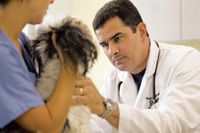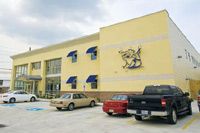Big Easy's rebound has been anything but for DVMs
New Orleans - Local veterinarians say growth doesn't mean their practices are brimming with clients, especially considering the number of clinics has declined, due to delayed construction, financial and other reasons, so that the number of practices remaining is just about on par with the client base.
New Orleans — Local veterinarians say growth doesn't mean their practices are brimming with clients, especially considering the number of clinics has declined, due to delayed construction, financial and other reasons, so that the number of practices remaining is just about on par with the client base.

Not an easy comeback: Steve Lemarie is one of several veterinarians seeing an increase in patients as people return to New Orleans three years after Katrina.
The rapid growth in the New Orleans metropolitan area — the city was named the fastest growing in the nation last year — has brought the population back to about half what it was before Hurricane Katrina struck three years ago, the U.S. Census Bureau reported in July.
Veterinarians throughout the region say some colleagues have continued operations virtually uninterrupted, while others are still waiting to rebuild. Still others have opted not to rebuild at all.
Between July 1, 2006, and July 1, 2007, the population of the New Orleans area jumped 13.8 percent to 239,124, according to the bureau's latest statistics on cities with populations of at least 100,000.

Lemarie opened Southeast Veterinary Specialists (right) in February.
That's just more than half the 453,726 people living there about two months before Katrina devastated the city and led to a near-total evacuation in August 2005.
"The growth is deceptive," says veterinarian Gary Levy. "This is not like Anytown, U.S.A., that has had this wonderful expansion. The city was decimated, and anybody coming back would mean growth."
For the most part, Levy sees native New Orleans residents returning home, which is a feat in itself considering "virtually every client in our ZIP code, about 80 percent, were in six to nine feet of water. They've had to completely start over."
But unlike other areas of New Orleans, such as the devastated Ninth Ward, his clients typically had the means to rebuild.
Levy estimates a third of the parcels in the Lakeview neighborhood, where his clinic was located before Katrina hit, are vacant, a third are untouched and the rest actually have habitable homes.
The only upside to that is that, in many cases, the people who did return have the opportunity to buy the lot next to them, which means a bigger yard, a bigger house and possibly more room for a dog, which would be a boon to Levy's practice.
Still, his clinic isn't suffering. "It's doing better than it has a right to," he says, attributing his success to the loyalty of his clientele. "It is at three quarters of what it was pre-Katrina. I'm very humbled and flattered by that."
With half the staff, one-third less square footage and still operating out of a temporary building, Levy considers himself fortunate.
He hopes to build a new clinic, but construction costs have delayed the project. Bids on the estimated $1 million project came in at $1.5 million, which means redesigning and going out for bids again. He hopes to open the new facility in 2009.
Veterinarian Steve Lemarie knows the frustration of getting a new facility built. He just moved into a new 19,000-square-foot referral hospital, Southeast Veterinary Specialists in Metairie, in February.
"Our practice is a referral practice, so we see clients referred from vets all over New Orleans," Lemarie says. "Our client base is great. We're growing and I think most vets in the area are seeing the same thing."
Again, Lemarie notes that the more affluent areas that were not as hard-hit are seeing growth.
The health problems assciated with the flood have long since retreated, but one veterinary service continues to be requested — microchipping.
Although the procedure doesn't have to be performed by a veterinarian, Dr. Patrick McSweeney says there was a big surge of microchipping right after Katrina and it continues today.
McSweeney's practice in Metairie was untouched by Katrina, but his home was destroyed.
He wasn't able to move back in until July of this year, and he is one of just two of the original residents on his block.
He estimates he lost about 25 percent of his clients and, like Levy, cited loyalty as the reason he retained as many as he did.
Dr. Bob Gros owned a clinic in St. Bernard Parish, but decided not to rebuild.
Gros, past president of the Louisiana State Veterinary Association (LSVA), spoke about the impact the storm had on New Orleans veterinary clinics at the American Veterinary Medical Association (AVMA) annual convention in July.
Today, Gros, 60, is part owner of an emergency animal hospital and opts to spend two days a week doing relief work for area clinics instead of dealing with the headaches of owning his own. He says some of his colleagues are doing quite well.
"The uptown area clinics actually are doing better," Gros says. "They became more densely populated as people needed places to live. The ones in the Metairie area became very densely populated, so most of those are reportedly doing better."
Although the growth is promising, the locals wouldn't say the city is seeing a real boom.
"I don't think it's fair to compare our city to other cities," Levy says.
"New Orleans was home to many people. People are just coming home vs. leaving other cities and moving into the area."